How to Dress a Lethal Lady: Looking Back at Pulp Fiction ’s Antiheroines
pulp /ˈpəlp/ n. 1. A soft, moist, shapeless mass of matter. 2. A magazine or book containing lurid subject matter and being characteristically printed on rough, unfinished paper.
When that definition first flashed across the screen, ’90s cult action film Pulp Fiction was born, with its punchy dialogue, sorry-not-sorry violence, and smug humor. Directed by Quentin Tarantino, the film turns 25 today; even then its rebel style and character banter seemed destined for greatness. (Or perhaps that’s the effect of time: Critic Roger Ebert described it as “either one of the year’s best films, or one of the worst” after it debuted at the Cannes Film Festival in May 1994.)
Onscreen we follow a menagerie of tangled connections: bossman Marsellus Wallace (Ving Rhames) and his wife, Mia Wallace (Uma Thurman); hitmen Vincent Vega (John Travolta) and Jules Winnfield (Samuel L. Jackson); stone-cold boxer with a heart of gold Butch (Bruce Willis) and French femme Fabienne (Maria de Medeiros); and modern-day Bonnie and Clyde Pumpkin (Tim Roth) and Honey Bunny (Amanda Plummer). A wild tale of guts and gore ensues, with a Travolta dance number to boot.
Needless to say these guys were dressed to kill. To celebrate the film’s quarter century, Vogue spoke to costume designer Betsy Heimann about the lethal ladies of Pulp Fiction and their key looks. Heimann, who also outfitted Tarantino’s Reservoir Dogs and Cameron Crowe’s Almost Famous, dished on everything from Uma Thurman’s ad hoc look from the oddball Jack Rabbit Slims Twist Contest to the importance of a great coat.
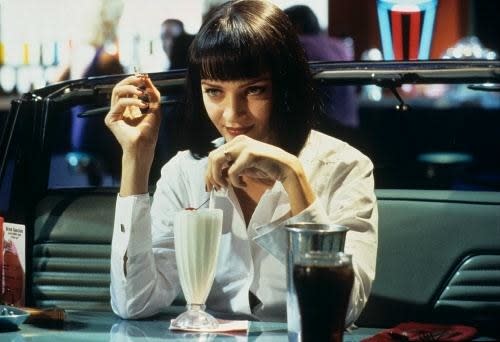
uma_thurman_pulp_fiction2.jpg
Photo: © Miramax / Courtesy Everett CollectionWhen you first heard about Pulp Fiction’s premise, what were your first thoughts? How did you go about interpreting the fashion?
You know, I started with Reservoir Dogs, so there was a history. Quentin and I just went to Barney’s Beanery and sat down and did the movie visually; that’s how we worked. We did the same thing with Reservoir Dogs, and we had a very visual dialogue. I just generally think about the character and who these people are. For example, I think Jules and Vincent are Reservoir Dogs. And Quentin said, “Yes, great!” And then I said, “But I think Vincent is kind of a mess, so let’s do something for him out of linen. And Jules is like a preacher, so let’s do something a little more retro ’60s with a very narrow collar.” It’s pragmatic and character driven. We had a very good time on both films.
What was it like working with Quentin Tarantino?
He was very new and very excited, and his enthusiasm was contagious. Your director should be the one that inspires you to do the film, and I was totally inspired. I was deep into, like I said, who are these people: Now, in this scene, he should have the bolo tie on; now he doesn’t; now he’s dancing; let’s change his jacket here. With [Mia] I was like, What do I want? “Son of a Preacher Man,” love that song, okay, I can see her dancing across the room! And then I would tell Quentin. In those years he was very collaborative, and he’s been very complimentary about our collaboration in front of people, which just makes me feel good.
I recently rewatched the film, and it still has such an impact. The clothes make such a statement.
Yes! For me the men, the women, it comes from reality. I know everyone always says my work is so cutting edge, so heightened reality, but it’s because I really try to make it real. It’s sort of like if I said to you, “What do you think a waitress from Idaho looks like?” You have a vision in your mind, but is that really the truth? Where is the truth in that?
Did you have any idea this film would turn out to be a cult classic?
No. See, to me the one that really took my breath away was Reservoir Dogs. In my career it’s about the material, and can I get the director’s vision on the screen, and that’s all it is. I like to try to be very particular. When I read Reservoir Dogs, I had never read anything like it. So when I read Pulp Fiction, I understood what was coming. I knew what I was reading, having worked with Quentin previously and understanding his style. I didn’t realize how funny it was until I saw the finished movie. It’s so silly, and I’m very serious. I have a really good time when I work.
Uma Thurman’s twist with John Travolta is one of my all-time favorite dance scenes. How did you pick her outfit?
So, Mia Wallace: wife of the big boss, tons of money, but inside she’s kind of a bad girl. She wants these guys to like her. She’s totally barred from interacting with any man, so she has a chance to go out one night with Vincent, and she’s like, “Well, I’m going to show them I’m a Reservoir Dog like they are.” That was my initial inspiration for the costume, and so [I thought], Let’s make a girl version. Let’s give her some fashion. She’s got money. She’s a tall, beautiful woman, and she can carry off all this fashion stuff. You could put her in a paper bag and put a belt on it, and she would be chicer than any person you’ve ever met.
And part of creating a real character is incorporating who the actor is. [Thurman] has this great body language and fabulous figure, so I said, “Let’s make it a little bigger. Let’s give her the white shirt, but let’s make the collar bigger, let’s make the cuffs bigger, let’s make it fit her a little better.” I’m sure you’ve heard this story. [Thurman] is so tall, and we didn’t have the money to buy her couture pants. I thought these pants fit her nicely, but they were too short—let’s cut them off! Let’s just make a statement. Let’s bring back the pedal pushers in a modern way. And [Thurman] said, “Oh, but my feet are so big!” I said, “Yeah, let’s show them off! Let’s pay homage to your rich husband and get you some gold Chanel pumps.” And she’s like, “Okay!”

Tell me about Amanda Plummer’s character, Honey Bunny.
Oh, she is so darling. We have to think back to the time of when we were filming. Now, that silhouette of that dress is very popular. That could’ve been from a thrift store, from anywhere—late ’80s, early ’90s. The little short dress with the sleeve and the kind of suppressed waist, and it buttons up the front, that was just something girls wore. I felt like she should have something she could’ve gotten from the thrift store because a lot of the vibe of these movies is thrift. It’s in a color that doesn’t call attention. You know, if she walked into the diner in a bright red dress, everyone would look at her, but this way she blends into the decor. She’s in the same tones as the decor of the diner, so when she stands on the table and she goes, “Okay, everybody!” it’s so unexpected. She looks like this demure, mousy little thing, and who knows the power inside.
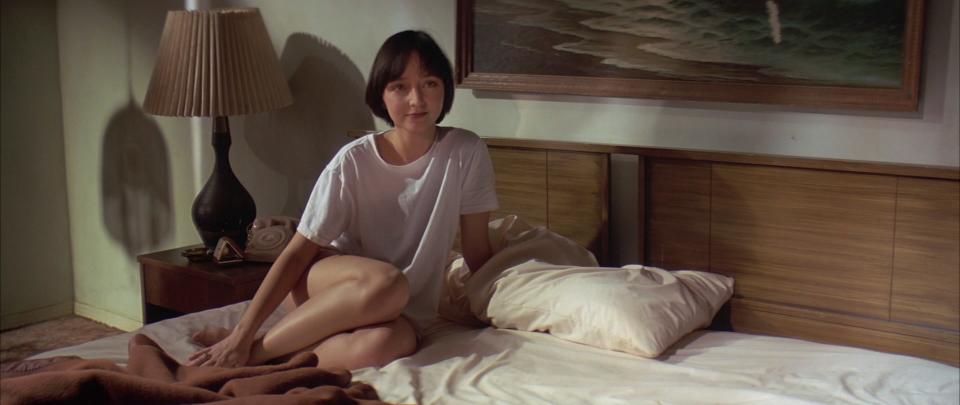
pulp_fiction_fabienne.jpg
Fabienne is just chilling in this white T-shirt. It’s such a classic look, a girl in a men’s white tee.
That’s it, particularly in those days. I remember around that time, maybe a little bit later, Rene Russo in Get Shorty, which is another film I designed. I had her in a Lakers T-shirt, and she’s padding down the hallway. In that time that was our sexy.
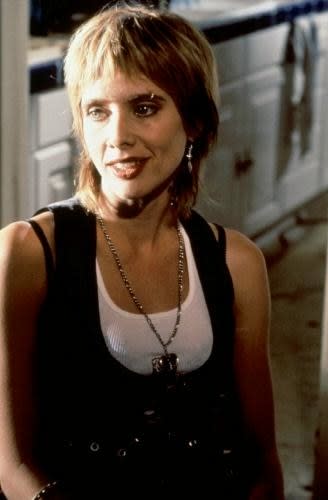
pulp_fiction_rosanna_arquette.jpg
How did you dress Jody (Rosanna Arquette)?
Jody and Trudi [Bronagh Gallagher] were so much fun. What was important about Jody and these people—she goes out, but [Lance, played by Eric Stoltz] never leaves the house. Lance is at home all the time in a bathrobe. By the way, that’s Quentin’s Speed Racer T-shirt he’s wearing. Quentin had shown me a Speed Racer cartoon, and I was like, “Yeah, I really like that idea for Lance.” And he was like, “Oh, I have a T-shirt!”
[Jody] is wearing the Chrissie Hynde look, you know, the vest over the tank. I love the vest. I think back to my references—I have a rock-and-roll past. A lot of my references for this film were a little cowboy, a little rock-and-roll.
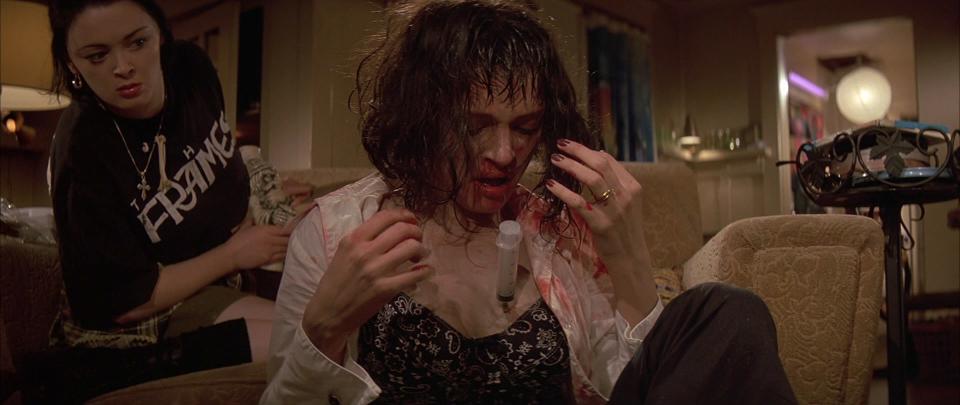
pulp_fiction_thurman_gallagher.jpg
Tell me about Trudi and her grungy look.
There’s a really interesting story about that T-shirt on Trudi. This is not the costume I originally fit on her. She said to me, “My friends are in a band called the Frames, and I want to wear their shirt, but my luggage is lost.” I said, “Let’s put you in a black T-shirt for right now.” I think I put a sleeveless flannel on top, something grunge, and I told her to put her shirt on once it showed up.

pulp_fiction3.jpg
Esmarelda Villalobos [Angela Jones]—the femme fatale cab driver with a fascination for violence. Why did you put her in red?
This is totally Quentin. I remember him coming to me and he said, “There’s a girl. I’m going to cast her as a taxicab driver. I saw her in a short film where she cleaned up after murderers. I’m going to put her in our movie.” When I looked at the outfit that she wore in that movie that struck him so, Curdled, it was a solid red dress. I was paying homage to the film with the red floral.
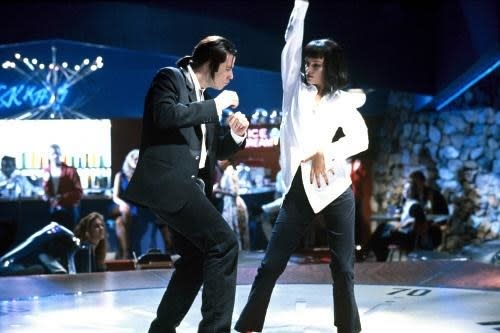
pulp_fiction_twist_travolta_thurman.jpg
And tell me about queen bee Mia Wallace.
There’s a couple of different thoughts on the background on this scene. I know that the original inspiration for this scene was a Godard film for Quentin, visually. In the end they settled on the twist because it was easier to do.

pulp_fiction_uma_thurman_trench.jpg
What was that wonderful trench coat?
That was my thing. I was so into that. It was [Vince’s] coat! It was a man’s gabardine trench coat from the ’50s that I got at a costume rental in L.A.—Palace Costumes. He gives it to her. I just had this vision of her dancing around the room, higher than a kite, with something to breathe out behind her.
It’s like a cape!
Yes, I have a fascination with coats. I’m big on the coats.
Originally Appeared on Vogue

